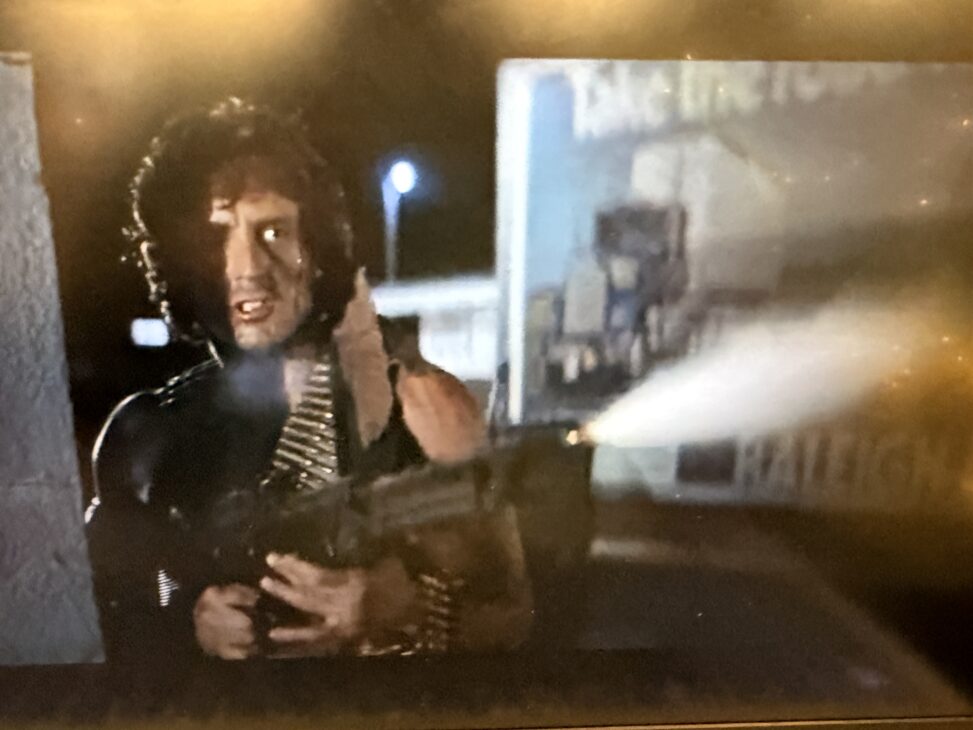The most recent Hollywood action film that I watched is Rambo First Blood. I chose a scene that happens towards the end of the movie where Rambo is firing a machine gun towards a building to try to distract the police officers from finding him.
This screen grab represents a dark night in a small town with only a handful of buildings. The biggest prop used is the machine gun that Rambo is holding and is using to shoot up glass windows of a building that is shown in the next scene. His outfit shows off his masculine look such as his big shoulder and biceps. It’s a very army looking outfit with the machine gun bullets wrapped around his body and a piece of cloth tied around his head like a headband.
Actor Sylvester Stallone plays John Rambo very well. In this scene he is standing while aiming the gun with an intense and angry look on his face, but throughout the movie he moves with purposeful, tense, and controlled movements. The machine gun and bullets flying out of the gun are very emphasized to make it look more aggressive along with Rambo and the gun being the center of the scene.
Throughout a minute’s length of a scene I notice about 22 cuts, some of which are sudden, while others flow smoothly between the scenes, as well as being quick when switching and filled with action, and since it’s quick, I barely notice the scene changes, however they are visible. The camera moves seamlessly without visibility of someone behind the it. The whole movie is considered violent, especially to those who aren’t used to this kind of production. When watching for edits in the film, my point of view doesn’t change and I still love watching it.
Lots of stars of earlier periods have shown emphatically and heavy masculine figures. The detail and definition of their bodies have not been crashed on. Arnold Schwarzenegger and Sylvester Stallone for example are not just late heroes; they are pumped up bodies add up to ‘masculinity’.
When researchers asked boys to name their favourite actors or action hero’s, there was almost no difference between the delinquent group and the non-delinquent group. Both sets of boys who were interviewed tended to choose the same movie stars like Arnold Schwarzenegger and Jean Claude van Damme who were the most popular. The pattern stayed very similar with other names such as Bruce Willis, Sylvester Stallone, and Bruce Lee appearing across both groups.
Linguists talk about words as having ‘marked’ or ‘unmarked’ forms. Not long ago, ‘he’ was used as an unmarked personal pronoun, so any reference to women had to be specifically marked. The same kind of idea goes for nouns. Words being ‘nurse’, ‘nanny’, and ‘secretary’ are mostly aimed at women and understood as feminine unless you add the word ‘male’ in front of it. On the other hand, words like ‘prisoner’, ‘criminal’, ‘defendant’, are automatically masculine in the unmarked form which explains why a lot of male actors are automatically positioned for specific roles.1
Throughout film history, you notice that different types of masculinity show up in Hollywood stars. In the 1980’s, actors like Eddie Murphy, Tom Cruise, and Harrison Ford stood out even though the decade was mostly filled with hypermasculine action heroes. Their style of masculinity was lighter and sometimes even less traditionally “tough”. This kind of softer or funnier masculinity isn’t new either.
While you could have easily talked about stars like Schwarzenegger and Stallone, as they are often seen as the face of 1980’s action films, in points out that not all action heroes of that era were hyper-muscular. This supports Barbara Creed’s idea that masculinity in films is performed, with the overly muscular hero acting as an exaggerated version of masculinity in which the original, authentic form is essentially lost.2
Most narrative film is made with the goal to construct a clear and coherent event structure so that the viewer can readily understand the sequence of events depicted in it. The juxtaposition of the content of two edited frames can be jarring and contain little feature overlap, but most often, a cut is intended to convey a continuous flow of events and be “invisible” to viewers.
Filmmakers can create a variety of combinations of continuities and discontinuities in space, time, and action across cuts. For example, interweaving actions that occur in different locations across cuts should lead to the perception that the events in the different locations are occurring concurrently in the story world.3
According to the Box Office Mojo, Rambo: First Blood made $47,212,904 domestic, $78,000,000 international and $125,212,904 worldwide! 4
The media is filled with violent and aggressive content, and years of research shows links between watching this kind of violence and having more aggressive thoughts, stronger expectations of hostility, and less prosocial or helpful behaviour. Seeing violent media can also make people more likely to assume others have hostile intentions.5
1. Criminol, “Masculinity and Heroism in the Hollywood ‘Blockbuster’”, 349-350.
2. Dolby, “Hollywood Masculinities: Themes, Bodies, and Ideologies in 1980s Hybrid Action Cinema”, 36-37.
3. Magliano, Zacks, “The Impact of Continuity Editing in Narrative Film on Event Segmentation”, para. 5.
4. Box Office Mojo, “Rambo: First Blood.”
5. Stockdale, Morrison, Kmiecik, Garbarino, Silton, “Emotionally anesthetized: media violence induces neutral changes during emotional face processing”, para. 1.
Bibliography:
-Brit. J. Criminol. “Masculinity and Heroism in the Hollywood ‘Blockbuster’.” No.3 (n.d) *36-3-348.pdf
-Aidan Dolby. “Hollywood Masculinities: Themes, Bodies, and Ideologies in 1980s Hybrid Action Cinema. Masters thesis, York St John University.” (2019) https://ray.yorksj.ac.uk/id/eprint/4477/1/DOLBY%20AIDAN%20FINAL%20THESIS.pdf
-Joseph P. Magliano, Jeffrey M. Zacks. “The Impact of Continuity Editing in Narrative Film on Event Segmentation.” (2011) https://pmc.ncbi.nlm.nih.gov/articles/PMC3208769
-Box Office3 Mojo. First Blood (1982). Accessed November 25, 2025 First Blood – Box Office Mojo
-Laura A. Stockdale, Robert G. Morrison, Matthew J. Kmiecik, James Garbarino, and Rebecca L. Silton. “Emotionally Anesthetized: Media Violence Induces Neural Changes During Emotional Face Processing.” Social Cognitive and Affective Neuroscience 10, no. 10 (2015): 1373–1382. https://academic.oup.com/scan/article/10/10/1373/1648617
-OpenAI. ChatGPT (GPT-5). “Assisted with citing sources in Chicago style and proper formatting and sentence flow.” ChatGPT, November 25, 2025. https://chat.openai.com/


Provide Feedback